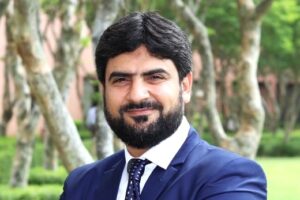
Dr Fawad Ur Rehman holds a PhD in Biomedical Engineering from the Southeast University, Nanjing, China and specialises in nanomedicine and nano-drug delivery systems. His research interest lies in developing Blood-Brain Barrier amenable nanoscale materials-based targeted therapies for brain diseases such as glioblastoma multiforme. At AKU-CRM he is currently leveraging his efforts to harness the potential of lipid nanoparticles and extracellular vesicles for the safe and efficacious delivery of gene editing tools. Before joining CRM, he was a group lead and senior postdoctoral fellow at Henan-MQ International Joint Center for Biomedical Innovation, Henan University, China. He was also a postdoctoral researcher at ZhongDa Hospital, affiliated with the Medical School of Southeast University, Nanjing, China.
Career profile of Dr Rahman covers: i) Assistant Professor, Centre for Regenerative Medicine and Stem Cells Research, Aga Khan University, Karachi, Sindh, Pakistan.; ii) Postdoctoral Fellow, Centre for Regenerative Medicine and Stem Cells Research, Aga Khan University, Karachi, Sindh, Pakistan. Nov 2021- Dec 2022.; iii) Postdoctoral Fellow, Henan -MQ University International Joint Center for Biomedical Innovation, Henan University, Kaifeng China, 2018 – 2021; iv) Postdoctoral Fellow, Department of Clinical Medicine (Hematology and Oncology), Medical School, Southeast University, Nanjing China, 2016 – 2018; vi) Teaching Assistant, Southeast University, Nanjing China, 2014 – 2015; vii) Laboratory Manager/ Officer-In-Charge, Semen Production Unit, Livestock and Dairy Development Department, FATA Secretariat, Warsak Road Peshawar, Pakistan, 2011 – 2013.
Dr Rahman is a member of the Grand Challenge Funded project of HEC “Developing Druggable CRISPR-Cas9 Based Therapies for Beta-Thalassemia and Sickle Cell Anaemia”. This pre-clinical research aims to develop druggable gene-editing therapies for beta-thalassemia and sickle cell anaemia. Using CRISPR/Cas9, a molecular gene-editing tool, the researchers aspire to fix a mutation in the haemoglobin beta-globin (HBB) gene that causes both these disorders. This new therapy could be injected as a drug to allow the defective part of the HBB gene to be sniped and repaired, enabling the production of normal haemoglobin.
The second therapy involves reactivating the production of foetal haemoglobin as a substitute for the deficient adult haemoglobin in beta-thalassemia and sickle cell anaemia. Dr Mian and his team will work on gene-silencing, using the same gene-editing tool and approach, suppressing the BCL11A gene that stops foetal haemoglobin from being produced.

